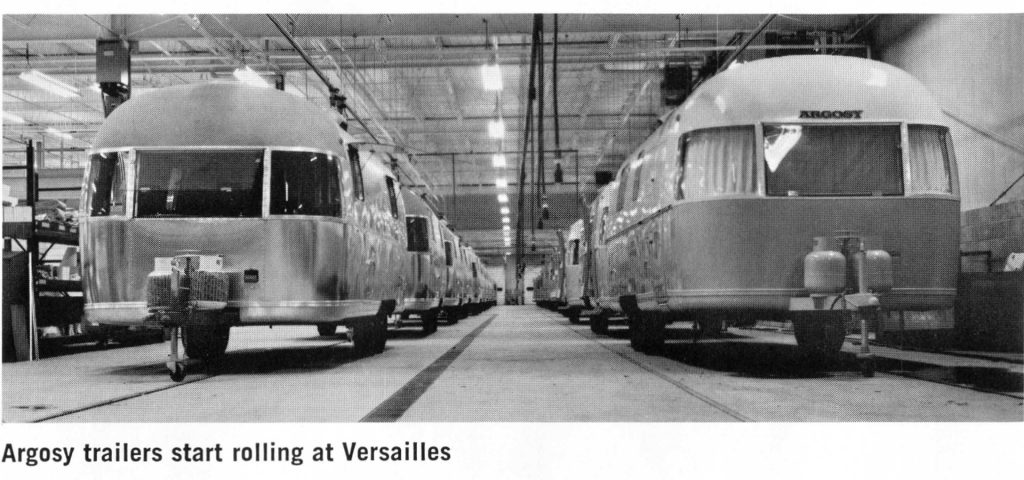
March 2022 marks the 50th anniversary of the Argosy travel trailer – a lesser known but nonetheless beloved product in Airstream history. With its instantly recognizable painted exterior, the Argosy line reached a new market and provided an important testing ground for product development. Let’s take a look back at how it all began.
The Argosy story began in the early 1970s as Airstream was looking to enter into the mid-priced travel trailer market. The company purchased a plot of land in Versailles, Ohio (36 miles down the road from Airstream’s Jackson Center plant) to construct a factory to build this new travel trailer. In the Fall of 1971, construction began on the 117,000 sq. ft. facility. Although the name of this new product had not yet been released, the vision was to create a travel trailer that would look like a member of the Airstream family. Management at Airstream announced that the new factory would initially employ around 200 associates including some transfers from the Jackson Center factory.
In February 1972 the name of this new product line was revealed – the Argosy. Named after a large merchant ship, Argosy embraced the long-standing Airstream tradition of incorporating nautical names into model names such as the Clipper, Flying Cloud, and Caravel. With its own style and logo, Argosy was poised to become a proper sub-brand.
On March 1, 1972 production began on the very first Argosy. This 26’ model was completed on March 21, 1972 and shipped to Northwoods Trailer Sales in Mt. Morris, Michigan (an Airstream dealer since 1963). According to the October 1972 sales report, the new factory produced 10 travel trailers a day and had begun shipping to dealers around the United States and Canada. One Argosy had even been shipped to a dealer in Germany. Initially offered in four lengths (20’, 22’, 24’ and 26’), Argosy production began as a batch run with the same size and model being produced one after another, although this approach would later be abandoned.
While the riveted aluminum, aerodynamic structure of the Argosy looked similar to an Airstream, less expensive equipment and component parts allowed the product to be offered at a lower price point. The Argosy’s painted exterior camouflaged its galvanized steel end caps as well as damaged aluminum panels which were occasionally used. In 1973, Argosy prices ranged from roughly $1500-$3500 less than comparable Airstream prices. To keep costs down, Argosy offered a 12-month guarantee rather than the Airstream lifetime guarantee. In addition, Airstream’s California plant began to produce Argosy Travel Trailers in 1974 to reduce shipping costs for west coast units.
Airstream management hoped that the Argosy customer would embrace the RV lifestyle and eventually trade up to own an Airstream. Although Argosy owners were not initially eligible for membership in the Wally Byam Caravan Club, it was advertised that the Argosy was part of “the Airstream pedigree.”
According to a 1973 advertisement, “Created by Airstream, the pioneers of the trailer industry, the Argosy brings the joy of travel adventure within the reach of nearly every fun-loving family. If you’re searching for a travel trailer of high quality at moderate cost, if you demand real engineering and a service program you can depend on…then the Argosy is meant for you.”
In addition to providing access to new markets, the Argosy line also provided an important testing ground for new product developments which, if successful, could be later incorporated into the main Airstream line. Some of these product innovations included wrap-around windows, rear door/front bed models, and more.
Perhaps one of the most significant product innovations to occur in the Argosy line was the 1974 introduction of the Argosy Motorhome. As the company’s first foray into the motorhome market, the shape of the Argosy Travel Trailer was adapted to fit the drive-train of the new Chevrolet chassis. Featuring a semi-monocoque, stress-skinned structure, wrap-around windows, and a painted beige exterior, the Argosy Motorhome was initially offered in 20 and 24 feet. Soon, Airstream also offered the Argosy Compact Bus, a commercial product modeled after the Argosy Motorhome, which became popular with municipal transport systems and similar clients. Airstream’s California plant began producing the Argosy Motorhome by 1975. A testament to the success of the Argosy Motorhome, the Airstream Motorhome was introduced in 1979.
Another significant product development in the Argosy line was the 1977 introduction of the Argosy Minuet. Advertised as the lightest self-contained travel trailer in the world, the Argosy Minuet was designed to be towed by a compact car and featured innovations including an aluminum composite subfloor.
As a recession and gas crisis hit American drivers hard in the late 1970s, it did the same to Airstream. In an attempt to streamline production processes, the Jackson Center factory began to produce Argosy Travel Trailers in 1978. After a move to consolidate, Airstream closed its California factory at the end of the 1978 model year and the Versailles factory ceased production of Argosy Travel Trailers in late 1978. For a brief time, a few Airstream Motorhomes were produced in the Versailles factory but ultimately the Versailles plant permanently closed and was sold to the Midmark Corporation in 1981.
The original Argosy line was discontinued after model year 1980 but the Argosy brand was briefly resurrected in the middle of the decade with the introduction of the 1986 Argosy Travel Trailer which featured a square body style and bonded aluminum skin. In 1988, Airstream introduced the Argosy 5th wheel. Both the Argosy Travel Trailer and the Argosy 5th wheel would ultimately be replaced by the similarly styled Airstream Land Yacht.
For many Airstream history enthusiasts, the Argosy holds a special place in our hearts. Today, Argosy owners are welcome members of the Airstream Club International and many of them have taken on restorations using the Argosy’s paintable surface as a platform for creative self-expression. Join us this month as we celebrate the 50th anniversary of this innovative Airstream cousin.















